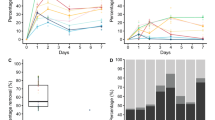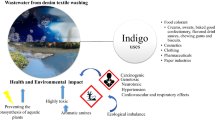Abstract
Hospital laundries are responsible for a significant part of the amount of wastewater that is generated in hospitals. Hospital laundry wastewater represents a complex mixture of chemicals that arouse concerns about possible environmental risks. The objective of the present study was to evaluate the cytotoxicity of different laundry effluents from the Regional University Hospital of Maringá, Paraná, Brazil, on Allium cepa L. meristematic root cells. The effluents were characterised as rinsing, wetting, prewashing, washing, softening, wastewater (the effluent generated at the end of the washing process), the wastewater that was treated by physicochemical (PC) processes and the wastewater that was treated by advanced oxidation processes (PC + UV, PC + H2O2 and PC + UV/H2O2). The mitotic indexes were calculated by scoring 5000 cells per group and the statistical analyses were performed by one-way ANOVA, followed by Tukey’s post-test (α = 0.05). Results showed that the rinsing, wetting, prewashing and wastewater laundry effluents were cytotoxic at 24 h of exposure, significantly reducing the mitotic index. Despite the slight cytotoxicity of the PC + UV/H2O2 treatment, physicochemical and advanced oxidation processes efficiently reduced the critical parameters of wastewater, such as the biochemical and chemical oxygen demands, to tolerable levels of effluent discharge. It is essential to perform constant monitoring of these effluents in order to reduce the possible occurrence of environmental impacts.

Similar content being viewed by others
References
Al Aukidy, M., Al Chalabi, S., & Verlicchi, P. (2018). Hospital wastewater treatments adopted in Asia, Africa, and Australia. In P. Verlicchi (Ed.), Hospital wastewaters: characteristics, management, treatment and environmental risks (pp. 171–188). Cham: Springer Nature.
Al Qarni, H., Collier, P., O’Keeffe, J., & Akunna, J. (2016). Investigating the removal of some pharmaceutical compounds in hospital wastewater treatment plants operating in Saudi Arabia. Environmental Science and Pollution Research, 23(13), 13003–13014. https://doi.org/10.1007/s11356-016-6389-7.
ANA/FIESP/SINDUSCON – Agência Nacional das Águas/Federação das Indústrias do Estado de São Paulo/Sindicato da Indústria de Construção do Estado de São Paulo. (2005). Conservação e reuso da água em edificações. São Paulo: Prol Editora Gráfica.
APHA – American Public Health Association. (2017). Standard methods for the examination of water and wastewater. Washington, DC: American Public Health Association.
Arslan, A., Veli, S., & Bingöl, D. (2014). Use of response surface methodology for pretreatment of hospital wastewater by O3/UV and O3/UV/H2O2 processes. Separation and Purification Technology, 132, 561–567.
Babatunde, B. B., Vincent-Akpu, I. F., & Aiwerioghene, A. N. O. (2016). Cytogenotoxicity screening of untreated hospital wastewaters using the Allium cepa test. Journal of Applied Sciences and Environmental Management, 20(3), 724. https://doi.org/10.4314/jasem.v20i3.27.
Babu, D. S., Srivastava, V., Nidheesh, P. V., & Kumar, M. S. (2019). Detoxification of water and wastewater by advanced oxidation processes. Science of the Total Environment, 696, 133961.
Beltifa, A., Alibi, S., & Mansour, H. B. (2020). Monitoring hospital wastewaters for their probable genotoxicity. Journal of Water and Health, 18(1), 1–7.
Brasil – Resolução CONAMA 430. (2011). Dispõe sobre as condições e padrões de lançamento de efluentes, complementa e altera a resolução no 357, de 17 de março de 2005, do Conselho Nacional do Meio Ambiente – CONAMA. Brasília: Diário Oficial da União.
Brillas, E. (2020). A review on the photoelectro-Fenton process as efficient electrochemical advanced oxidation for wastewater remediation. Treatment with UV light, sunlight, and coupling with conventional and other photo-assisted advanced technologies. Chemosphere, 250. https://doi.org/10.1016/j.chemosphere.2020.126198.
Buelow, E., Rico, A., Gaschet, M., Lourenço, J., Kennedy, S. P., Wiest, L., Ploy, M. C., & Dagot, C. (2020). Hospital discharges in urban sanitation systems: Long-term monitoring of wastewater resistome and microbiota in relationship to their eco-exposome. Water Research X, 7(1), 100045.
FEPA – Federal Environmental Protection Agency (1991) S.I. 8: National Environmental protection (effluent limitation) regulation for all categories of industries. FEPA Monograph 2. http://extwprlegs1.fao.org/docs/pdf/nig120290.pdf. Accessed 28 June 2019.
IAP – Instituto Ambiental do Paraná, Resolução 70/2009 do Conselho Estadual de Meio Ambiente – CEMA – Dispõe sobre o licenciamento ambiental, estabelece condições e critérios e dá outras providências, para Empreendimentos Industriais.
Iqbal, M., & Bhatti, I. (2014). Genetic diversity in chestnuts of Kashmir valley. Pakistan Journal of Agricultural Sciences, 51(4), 1041–1047 http://www.pakjas.com.pk. Accessed 26 July 2019.
Kanakaraju, D., Glass, B. D., & Oelgemöller, M. (2018). Advanced oxidation process-mediated removal of pharmaceuticals from water: a review. Journal of Environmental Management, 219, 189–207.
Kern, D. I., Oliveira Schwaickhardt, R., Lutterbeck, C. A., Kist, L. T., Alcayaga, E. A. L., & Machado, Ê. L. (2015). Ecotoxicological and genotoxic assessment of hospital laundry wastewaters. Archives of Environmental Contamination and Toxicology, 68(1), 64–73. https://doi.org/10.1007/s00244-014-0072-0.
Miklos, D. B., Remy, C., Jekel, M., Linden, K. G., Drewesa, J. E., & Hübner, U. (2018). Evaluation of advanced oxidation processes for water and wastewater treatment – a critical review. Water Research, 139, 118–131.
Nidheesh, P. V., Zhou, M., & Oturan, M. A. (2018). An overview on the removal of synthetic dyes from water by electrochemical advanced oxidation processes. Chemosphere, 197, 210–227.
Oliveira Schwaickhardt, R., Machado, Ê. L., & Lutterbeck, C. A. (2017). Combined use of VUV and UVC photoreactors for the treatment of hospital laundry wastewaters: reduction of load parameters, detoxification and life cycle assessment of different configurations. Science of the Total Environment, 590–591, 233–241. https://doi.org/10.1016/j.scitotenv.2017.02.218.
Paz, M., Muzio, H., Mendelson, A., Magdaleno, A., Tornello, C., Balbis, N., & Moretton, J. (2006). Evaluation of genotoxicity and toxicity of Buenos Aires city hospital wastewater samples. Journal of the Brazilian Society of Ecotoxcology, 1(1), 1–6. https://doi.org/10.5132/jbse2006001001001.
Rueda-Marquez, J. J., Levchuk, I., Ibañez, P. F., & Sillanpää, M. (2020). A critical review on application of photocatalysis for toxicity reduction of real wastewaters. Journal of Cleaner Production, 258, 120694.
Silva, J. S., Heck, M. C., Buzo, M. G., Almeida, I. V., & Vicentini, V. E. P. (2018). Evaluation of textile laundry effluents and their cytotoxic effects on Allium cepa. Environmental Science and Pollution Research, 25, 27890–27898. https://doi.org/10.1007/s11356-018-2813-5.
Verlicchi, P. (2018). Hospital wastewaters: characteristics, management, treatment and environmental risks. Cham: Springer Nature.
Verlicchi, P., Al Aukidy, M., & Zambello, E. (2015). What have we learned from worldwide experiences on the management and treatment of hospital effluent? — an overview and a discussion on perspectives. Science of the Total Environment, 514, 467–491. https://doi.org/10.1016/j.scitotenv.2015.02.020.
Villarín, M. C., & Merel, S. (2020). Assessment of current challenges and paradigm shifts in wastewater management. Journal of Hazardous Materials, 390, 122139. https://doi.org/10.1016/j.jhazmat.2020.122139.
Zotesso, J. P., Cossich, E. S., Janeiro, V., & Tavares, C. R. G. (2017). Treatment of hospital laundry wastewater by UV/H2O2 process. Environmental Science and Pollution Research, 24(7), 6278–6287. https://doi.org/10.1007/s11356-016-6860-5.
Author information
Authors and Affiliations
Corresponding author
Ethics declarations
Conflict of interest
The authors declare that they have no conflict of interest.
Additional information
Publisher’s note
Springer Nature remains neutral with regard to jurisdictional claims in published maps and institutional affiliations.
Rights and permissions
About this article
Cite this article
Furtado, A.O., Almeida, I.V., Almeida, A.C.C. et al. Evaluation of hospital laundry effluents treated by advanced oxidation processes and their cytotoxic effects on Allium cepa L.. Environ Monit Assess 192, 360 (2020). https://doi.org/10.1007/s10661-020-08328-9
Received:
Accepted:
Published:
DOI: https://doi.org/10.1007/s10661-020-08328-9




